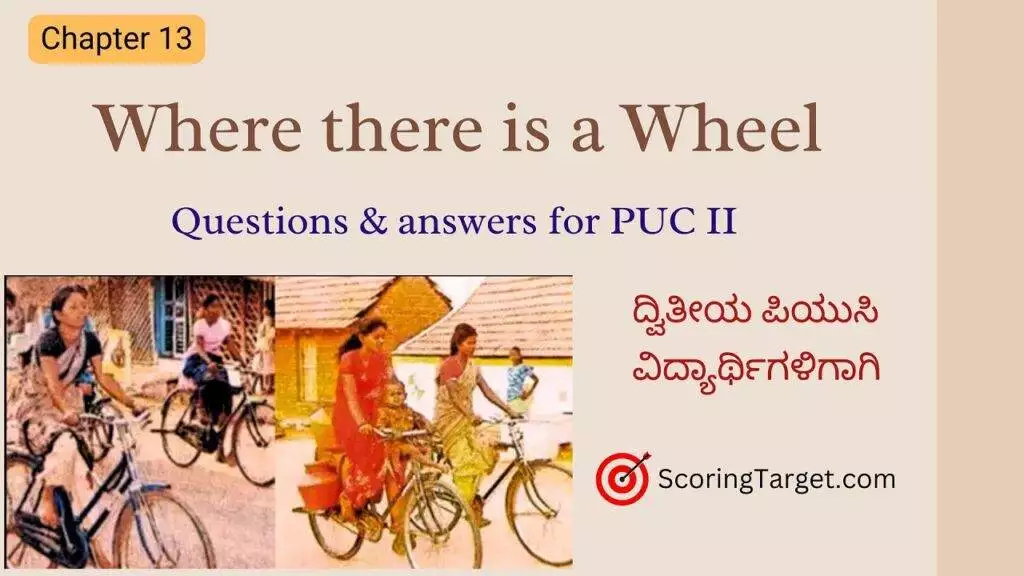Where there is a Wheel questions and answers for class 12. Notes of the lesson Where there is a Wheel for PUC second year students.
In this post we are going to learn Where there is a Wheel question and answer for Second PUC. Where there is a Wheel notes of Karnataka state syllabus.
Chapter 13 Where there is a Wheel important notes. KSEEB solutions for class 12. PUC II English notes.
To get more video notes for class 12, visit our YouTube channel. This channel is very useful for PUC exam preparation.

Notes of the lesson Where there is a Wheel for PUC second
Chapter 13
Where there is a Wheel
Important questions and answers
Comprehension I
1. What does cycling as a symbol of social mobility mean?
Answer: Cycling as a symbol of social mobility means freedom, independence, and mobility for rural women.
2. When Jameela Bibi says, “It is my right. We can go anywhere”, she is
a. asserting her right to move freely.
b. suggesting mobility leading to liberation.
c. expressing her indifference to dirty remarks.
d. boasting about her cycling skill.
Answer: b. suggesting mobility leading to liberation.
3. What does a bicycle represent for rural women?
Answer: The bicycle represents independence, freedom, and mobility to women.
4. What is common between Neo-literates and Neo-cyclists?
Answer: Neo-literates and Neo-cyclist women are naturally dependents on each other and they help each other in cycling.
5. ‘Enforced routine’ and ‘male imposed barrier’ refers to
a. confining women to the kitchen.
b. subjecting women to drudgery.
c. status of women in patriarchal society.
d. lack of freedom of movement.
Answer: b. subjecting women to drudgery.
6. How did the men react to women took to cycling?
Answer: Men made dirty comments at women who were cycling.
Where there is a Wheel notes of Karnataka state syllabus
7. What do the phrases ‘flags on the handle bar’ and ‘bells ringing’ suggest?
Answer: On International Women’s Day in 1992, women cyclists celebrated by tying flags to their cycle handlebars and ringing their bells to grab people’s attention and show pride in their achievements.
8. Why did UNICEF sanction mopeds to Arivoli women activists?
Answer: UNICEF was impressed when they saw 70,000 women taking part in cycling events and contests. As a result, they gave fifty mopeds to Arivoli activists to help them spread the word about cycling and literacy.
9. Why is the cycle called ‘the humble vehicle’?
Answer: The cycle is called the humble vehicle because it’s affordable, easy to maintain, and useful for many tasks. It also helps keep people healthy, making it a simple but valuable tool for everyday life.
Comprehension II
1. What is the role of Arivoli Iyakkam in liberating women?
Answer: Arivoli Iyakkam started a cycling movement for women. N. Kannammal, a leader in this movement, said cycling gave women confidence and made them less dependent on men. Arivoli held camps to teach women how to cycle, and they even held events for women to show off their skills.
2. In what different ways does the cycle empower rural women?
Answer: Cycling helps rural women become more independent. They don’t have to rely on men for help, can travel faster, and carry things to the market easily. Women don’t need to walk long distances for water, and children can ride bicycles to school instead of waiting for buses. Cycling also gives women more self-respect.
KSEEB solutions for class 12
3. Why does the author describe the Arivoli ‘cycling training camp’ as an unusual experience?
Answer: The author says the cycling camp was special because women dressed nicely and were very excited to learn cycling. They wanted to escape from everyday tasks like cooking and fetching water. While cycling, they even sang songs, showing how much they enjoyed the experience.
4. Do you think neo-literate women taking to cycling contribute to literacy movement?
Answer: Yes. cycling helps just like learning to read. It gives women freedom, independence, and confidence. In 1991, Sheela Rani Chunkath, a district collector, trained women in cycling as part of a literacy program. Cycling turned out to be more powerful than literacy for these women. It helped them support their families and be more independent.
5. How does Sheela Rani Chunkath, the district collector, promote the empowerment of women?
Answer: Sheela Rani Chunkath, a former District Collector, in 1992, decided to teach women cycling as part of a literacy program to help them move around more easily. She knew that not being able to travel hurt their confidence. She also asked banks to give loans to women who wanted to buy bicycles.
6. How did the women react to the shortage of ladies’ cycles?
Answer: When there weren’t enough ladies’ cycles, the women started using men’s cycles. Some women found it helpful because the bar between the seat and handlebar allowed them to carry their children.
Where there is a Wheel question and answer
Comprehension III
1. How does P. Sainath show that cycling brings about changes beyond economic gains?
Answer: P. Sainath explains that cycling gave rural women freedom and independence, helping them feel confident. It allowed them to do their own work, like selling goods at the market, without relying on men, and it helped them break free from a male-dominated society.
2. ‘O sister come learn cycling, move with the wheel of time…’ How does the song suggest that the cycle could be an instrument of social change and progress?
Answer: The song suggests that cycling is a way to bring about social progress. It changes the lives of rural women in India by giving them more options and freedom in life.
Click to download Where there is a Wheel pdf notes
Watch this video for the explanation of Where there is a Wheel questions and answers for class 12.